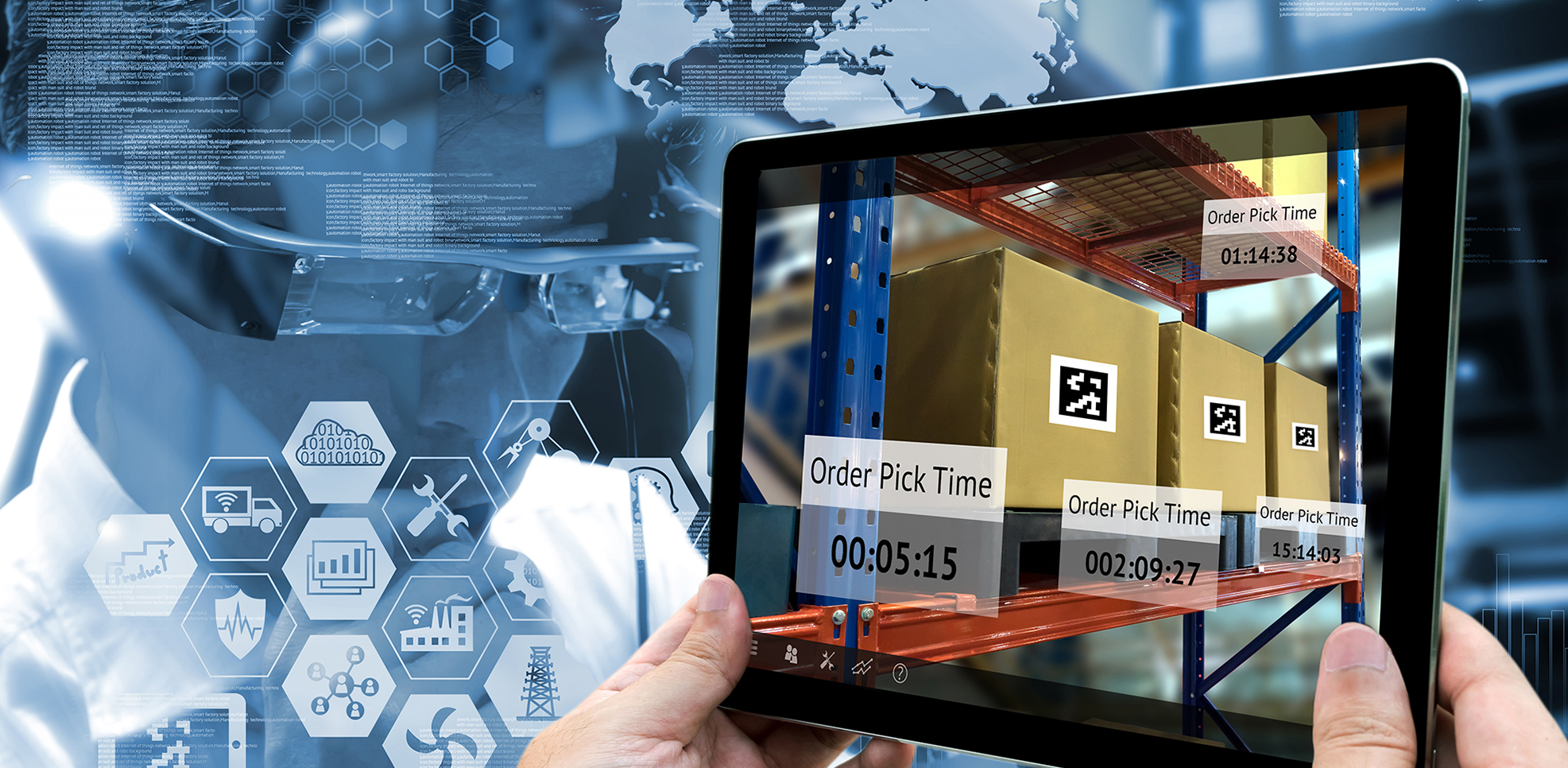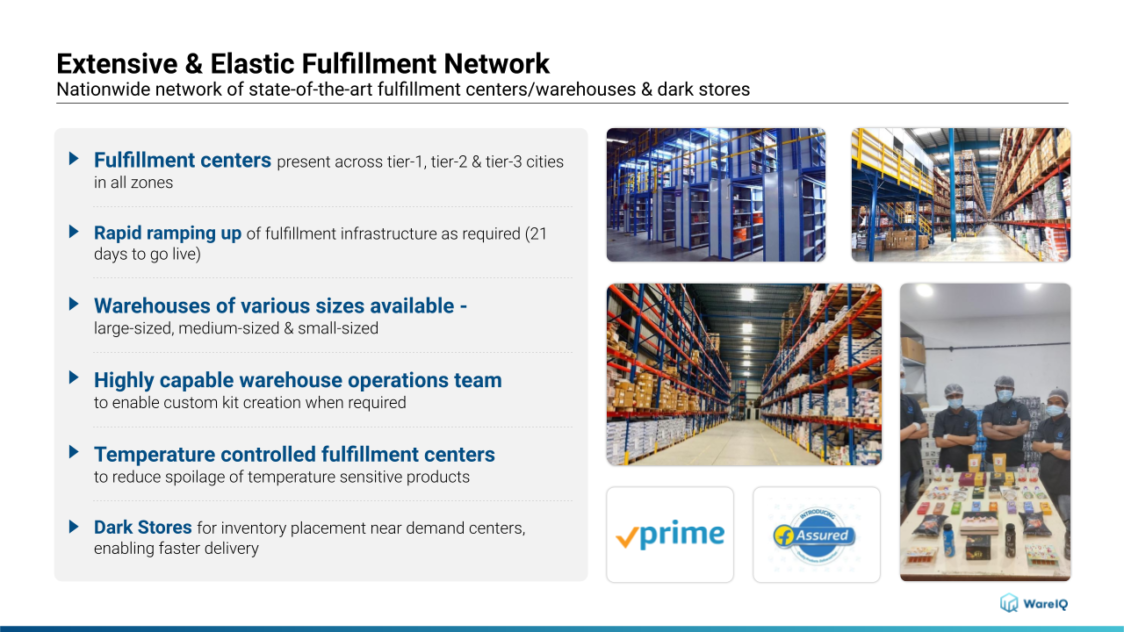What is Smart Warehouse Management System? Features, Components, Best Practices and Primary Benefits of Having a Smart Warehousing Technology in 2025

The term “competitive advantage” describes the qualities that give a business an edge over its rivals in the market. For example, these characteristics might lower the price of goods or services, influence consumer preference, or prevent competitors from entering the market.
One crucial area where businesses can obtain a significant competitive advantage is logistics. A rising percentage of individuals are purchasing goods online today. eCommerce is expanding at a rate of about 20% per year. Today’s warehouses use collaborative mobile robots, automated picking solutions, warehouse analytics, and warehouse management systems (WMS) to boost productivity and meet demand.
Every day, technological advances enable us to complete tasks more quickly, effectively, and without much trouble. Because of this, the concept of smart warehousing technology isn’t some far-fetched science fiction fantasy; instead, it is a quickly developing necessity.
A “smart warehouse” offers businesses significant benefits in the marketplace. Let’s examine the advantages in the market achieved by switching to a smart warehouse.
- What is Smart Warehouse Management System?
- Components Of Smart Warehousing Technology
- 7 Top Benefits Of Having A Smart Warehouse Management System in 2025
- Best Practices For Smart Warehouse Management System
- Conclusion
- WareIQ's Tech-Enabled Smart Warehousing Solutions
- Smart Warehouse Management System FAQ: Frequently Asked Questions
What is Smart Warehouse Management System?
The epitome of warehouse automation is a smart warehouse (in other words, automating various components of your warehousing operations). A smart warehouse management system is equipped with several automated and networked technology, similar to smart houses. Together, these technologies improve the warehouse’s production and efficiency while reducing the number of human workers and their faults.
In manual warehouses, we typically saw personnel going around with lists, picking things, placing them into carts, and then transporting them to the shipping docks. In contrast, orders are received automatically, after which the system validates if the products are in stock. The requested items are subsequently put into containers by robot carts and then sent to the workers for pickup using the pickup lists.
Real-time updates, the optimization of manual activities, and more automation are all achievable with smart warehousing technology but not in conventional warehouses. This tactic allows employees the time to concentrate on assignments of high value. A fully automated warehouse reduces human interaction while increasing operational scalability.
The smart warehousing market is predicted to grow from $3,944.06 million in 2021 to $9,400.10 million in 2027, according to a report by Research and Markets. Customers’ expectations are changing as warehouses get more sophisticated. Conventional warehouses cannot meet modern client needs.
Smart warehousing technology must be implemented to address the issues that today’s supply chains are experiencing.

How is Smart Warehousing Different From a Manual Warehouse?
As the name implies, a manual warehouse relies on employees to install and carry out tasks like picking products, putting them in carts, and bringing them to the shipping port.
These tasks are now automated in smart warehouses. The WMS automatically receives orders and determines whether the products are in stock. If so, the pickup lists are sent to the robotic carts, which put the products in containers before giving them to the workers for the following action. If not, the warehouse and distribution services management system alerts you to make the necessary stock purchases.
Key Features Of Smart Warehousing
The result of several networked warehousing technologies working together is smart warehouses. They outline a technological ecosystem in which products are automatically received, recognised, arranged, sorted, and pulled for transportation. When implementing smart warehousing technology, it’s important to remember some characteristics that make a system successful. Some of these qualities include:
Agility
Agile smart warehouses are required to quickly adapt to manage the rapidly changing variables in today’s world as warehousing operations become more complicated. The smart warehouse management system should constantly optimise the movement of goods from storage to shipment. Furthermore, in the event of a brief stock overflow, smart warehouse operations should keep an eye out for chances for temporary storage and third-party logistics (3PL) providers. Agility is also a vital component of the many software programmes used in a smart warehouse. This suggests that all systems should be compatible with various platforms, sales systems, and other warehousing features. As they are frequently regarded as standards in many industries, one may consider employing software as a service (SaaS) solutions.
Suggested Read: Why is Supply Chain Agility Crucial to eCommerce?
Storage Scalability
With the future in mind, smart warehouses must be sufficiently scalable. They will be able to accept significant product influxes and sudden product releases in this way. This brings up a further important aspect of SaaS solutions. Adding new capabilities to smart warehousing solutions may be challenging if you have an on-premise cloud solution. While upgrades are being made, the entire system could occasionally need to be shut down. This may cause a significant slowness in the warehouse. This restriction is not an issue for a SaaS solution because updates can be made immediately, and new features may be added without affecting performance.
Inventory Visibility
Data visibility has become critical for most supply chain software as technology advances. This is incredibly important right now. Software solutions should be prepared to update and store data instantly as supply chains and warehouse activities become more complicated. Customers and stakeholders want to use the real-time data the smart warehousing system provides to access the location of their products right now. Smart warehouses should make it possible for interested parties to find what they need quickly. Data visibility is crucial not just for client retention but also offers the business itself a wealth of relevant information. Thanks to real-time data, operators get a bird’s-eye view of the entire warehouse and how its various divisions perform.
WareIQ, an eCommerce fulfillment company, empowers online brands with a superior-tech platform to compete with Amazon like service levels by bringing their average delivery timelines from 5-10 days to 1-2 days.
Components Of Smart Warehousing Technology
An intelligent warehouse consists of several interconnected parts and technologies that work together to achieve a single objective. Thanks to each piece of this puzzle, the warehouse operates at its peak efficiency. Consequently, effective communication between those components must be ensured to construct a smart warehouse. Here is a list of the essential elements that a smart warehouse needs to have.
Robotics In Warehousing
Warehouse robotics is the first thing that comes to mind when we think of logistics innovation. They raise productivity and decrease labour expenses while also increasing order accuracy.
The main advantage is that your team won’t be distracted by time-consuming chores and can instead concentrate on how to enhance and optimise operations.
Employing robotics in warehouse management in the following ways-
- Automated Picking- Robotics is the ideal automatic picking tool since they ensure that orders are picked up two to three times more quickly than usual. The picker and these robots can rapidly and accurately remove charges from the shelves.
- Enhances inventory visibility- Despite their futuristic appearance, drones significantly improve inventory visibility for your warehouse operations. These machines can roam your warehouse independently and carry out inventory audits, cycle counts, item searches, etc.
Artificial Intelligence
Supply chain data is analysed and learned from by artificial intelligence (AI) to assist you in keeping one step ahead of any possible problem. Integrating AI can completely alter your warehouse operations by forecasting the future and assisting you in making wise business decisions.
Using artificial intelligence:
- Enhances Storage: Your AI-powered system can notify you if you are going to run out of storage space. You can then plan to decrease inventory levels or improve storage space.
- Reduces Risks: AI may assist you in anticipating future crises like overstocking, understocking, shipment delays, etc., by analysing historical sales data, real-time market movements, current inventory levels, and other data points. With this information at your disposal, you can try to prevent such circumstances.
Warehouse Management Systems (WMS)
The usage of a WMS is the icing on the smart warehouse technology. You can monitor how well your warehouse’s daily operations are going and see if there is anything you can do to make them more effective with a WMS system. Since most WMS solutions can gather real-time data and produce visual reports, they aid in exposing any flaws in warehouse operations. One can take the necessary measures to address problems and resume operations after viewing a WMS report.
Guided Automated Vehicles
Automated Guided Vehicles (AGVs) are a valuable tool for speeding up your warehouse putaway, loading, and stocktake processes for storage and retrieval. Forklifts and pallet carts are self-guided AGVs and follow digital pathways within the plant as they load and unload pallets, cartons, and other containers.
The option to add and expand your accessibility to AGV tools is necessary, which aligns intending to grow your business. In addition, these vehicles can be introduced in your warehouse without requiring a total redesign of your layout and systems.
Robots and Drones
Drones are used for safe and simple access to distant, challenging regions within a warehouse. Drones are outfitted with cameras, sensors, RFID, or barcode scanners, making them quicker and more precise than manual methods. Other inventory activities locate objects, carry out stocktakes, and do cycle counts. Cobots, or collaborative robots, on the other hand, cooperate with people and automate laborious or repetitive tasks like machine feeding, material handling, or assembly tasks.
Internet Of Things
The Internet of Things (IoT) entails several internet-connected gadgets that exchange data and communicate with one another. Robots may connect with all the technological systems required in intelligent warehouse systems, such as a warehouse management system (WMS).
For instance, a product is delivered to a warehouse. A radio-frequency identification (RFID) scanner reads the tags as the cargo is received, informing a warehouse management system (WMS) of which and how many items were received.
RFID here aids in inventory management and organization. Robots are then told by the WMS where those items should be stored on the warehouse floor. Everything is automatic and seamless without any critical data being lost.
Without IoT, each process step would need to be carried out manually by a human employee. As a result, the vast amount of data about each product that passes through these systems is prone to inaccuracy. But because of IoT, humans are almost entirely removed from the process, accelerating it and lowering error rates.
The Global IoT in Warehouse Market is anticipated to reach USD 17.93 billion by 2025, rising at a CAGR of approximately 21.21% by the end of 2025, according to a 2019 analysis.
Automated Storage and Retrieval Systems
Automated systems for storing information and retrieving it are not new. However, although they have increased throughput and accuracy, they have also frequently come under fire for being pricey, inconvenient, and rigid. Despite this, modern AS/RSs preserve all initial benefits, such as lower labour costs and restrictions, modularity, and improved accuracy, while continuing to look better.
To make your warehouse more innovative and effective, you don’t need to redesign it completely; instead, start by using the technologies that make sense for your company and its activities. You’ll then realise that any warehouse can transform into a smart warehouse.
7 Top Benefits Of Having A Smart Warehouse Management System in 2025
Today’s warehouses use collaborative mobile robots, automated picking solutions, warehouse analytics, and warehouse management systems (WMS) to boost productivity and meet demand. A smart warehouse offers businesses significant benefits in the marketplace. Let’s examine the advantages in the market achieved by switching to a smart warehouse and its perks.
Expedited Shipment
Order processing requires a disproportionately long length of time in a conventional warehouse. To pick products and fill orders, associates frequently spend a lot of time moving about the warehouse floor. Picking mistakes also add to the processing, sorting, and packaging of order delays. The average warehouse is thought to have a picking error rate of 1% to 3%.
Intelligent warehouse solutions can almost eliminate picking errors. First, automated picking methods and collaborative mobile robots reduce order picking time and spare warehouse workers from long walks. These elements aid in expedited order shipping. Second, only from the product’s price importance, shipping time is crucial for eCommerce customers when making a purchase.
In this era of eCommerce dominance, faster shipping is a crucial competitive advantage.
Minimises Human Error
The warehousing process is intricate, volume-driven, and has many moving elements. Therefore, manually picking, packing, and shipping items at a warehouse will likely result in human error.
However, you can drastically lower human error while saving on labour costs with the appropriate intelligent warehouse technology.
Digitizing warehouse procedures increases order accuracy, allowing you to guarantee a great customer experience. It might be as easy as adopting an inventory scanner system, integrating automated order processing, or investing in automated guided vehicles (AGVs) to accept, pick, and dispatch orders.
Increased Utilization Of Warehouse Space
Smart warehouses can make better use of their available space. For example, because traffic and aisle congestion is reduced compared to traditional warehouses, automated picking and mobile sorting solutions can enable higher racks and narrower aisles, increasing the number of goods that can be stored in the same amount of space.
Utilizing warehouse space more effectively lowers overhead expenses per sold item. The operator may pass these cost savings to customers through lower prices or increased profit margins.
Lower Expenses Result In Lower Prices
Average labour costs account for about two-thirds of warehouse operating costs, and for the warehousing sector as a whole, average wages have been increasing for more than a decade.
Smart warehouses optimise the effectiveness of human warehouse associates and reduce the need for human labour, which helps to cut operational expenses. Consumers may pay less for goods and services due to these cost savings. Customers frequently base their purchasing decisions on product prices; thus, being able to charge less for comparable goods is a huge competitive advantage.
Expedites The Fulfilment Of Orders
Due to a lack of technology and logistics automation, inventory distribution, and inventory allocation, all of which are essential to improving the fulfilment process, retail fulfillment is frequently delayed.
You and your team will also need to devote more time to logistics operations as your order volume increases, taking away from other crucial business activities.
Data is gathered and aggregated through smart warehousing methods, technology, and automation, providing insights on enhancing the fulfillment services. The outcome? is a quick, accurate, and effective fulfilment procedure that meets consumer expectations.
For instance, WareIQ is a distribution and fulfilment partner with a robust retail fulfilment infrastructure and distribution management system supported by cutting-edge digital logistics technology.
Orders are automatically routed to one of our fulfilment centres that store your inventory as soon as they are created or loaded into your WareIQ dashboard. Our tech distributes orders to our picking team, who receives a packing list of the items, amounts, and storage locations at our facility to obtain and finish their collection of products.
Efficient Warehouse Optimization
Utilizing intelligent technologies can increase warehouse productivity and streamline the process of various fulfilment procedures. With advanced analytics powered by machine learning algorithms, warehouse managers can monitor inventory flow, improve storage, and lessen process chokepoints. The data-driven strategy makes monitoring important performance indicators easier and allows the warehouse to operate more efficiently and provide better customer service.
The early detection of issues and potential threats in the supply chain is another capability of such cutting-edge systems. Data on inventory and supplier concerns gives warehouse managers the ability to be more proactive than reactive.
Enhanced Customer Services
Every item in a warehouse finally makes its way to the buyer. Customer service, experience, and satisfaction should therefore be given careful consideration. Smart warehousing solutions allow companies to better engage with customers, adapt to changing demands, provide support, and enhance the overall experience. Because of faster shipping, lower costs, and quicker responses, businesses can expand their customer base. Additionally, this will improve client satisfaction and the overall customer experience.
Best Practices For Smart Warehouse Management System
Smart warehousing technology helps to prevent unnecessary bottlenecks and empty shelves. Here is a list of smart warehouse best practices to assist supply chain decision-makers in getting the most out of automation and smart warehouse technology.
Re-Consider Your Warehouse Structure
For the best results, smart warehousing needs more room and well-organized spaces. Therefore, starting with a warehouse set up to become smart technology-ready is crucial.
Finding the parts of your warehouse operations that require technical help is the first step in optimising your warehouse space. For instance, a WMS may not directly affect the design of the warehouse layout, but it may impact how you arrange your equipment and workstations.
Take the time to prepare your warehouse layout design before investing in technology to enhance warehouse operations. This will help you save money on storage and accelerate the fulfilment process without using any technology.
Smart Warehouse Optimization
The warehouses must utilise the most recent technologies and procedures because the eCommerce sector is demanding.
Optimising warehouse layouts, slotting, and inventory movement is critical to keep up with the supply chain’s dynamic nature and the consumer’s constantly shifting demands.
Regular warehouse audits are necessary for smart warehouse optimization, and the findings must be implemented.
Practice Demand Forecasting
WareIQ’s fully integrated fulfilment network offers the data and analytics required to assist with demand forecasting if you need to anticipate which products your consumers will want at various periods of the year.
Intelligent inventory forecasting using previous orders and information about impending events can help you manage inventory, reduce shrinkage, save money on storage, and maintain satisfied customers.
With the correct information, you can choose when to conduct a flash sale, stop selling a product that isn’t doing well, or decide how much inventory to order based on seasonality.
Conclusion
Any warehouse operation can be considerably optimised with the help of smart warehousing. Most of the process is automated with the best smart warehouse systems, from suppliers to customers, with few mistakes. Also Read warehouse management vs inventory management
Increasing numbers of warehousing businesses will employ automation as it becomes more prevalent. Deep technology today is developing an ecosystem of smart warehouses that deliver the agility, flexibility, and responsiveness supply chains require in terms of visibility and visibility.
WareIQ’s Tech-Enabled Smart Warehousing Solutions
WareIQ, a 3PL warehousing company in India provides cutting-edge innovative warehousing solutions as a full-stack, tech-enabled fulfilment partner. You can maintain competitiveness by working with a tech-savvy fulfilment partner like WareIQ, which offers smart warehousing solutions.

Retail organisations, whether new or established, use the most modern technologies to improve the cost-effectiveness and efficiency of operations, from warehouse receiving to the fastest shipping.
With best-in-class technology, WareIQ is a nationwide fulfilment service provider that offers online merchants an advanced, end-to-end supply chain solution.
WareIQ may help you decrease shipping costs, shorten transit times, and offer more value to your consumers by automating warehouse processes, including selecting, packaging, shipping, inventory management, and more.
Additionally, WareIQ merchants have access to a strong fulfilment network that enables cost-effective 2-day shipping and further expansion into fulfilment facilities abroad.
- Pan India Fulfillment & Darkstore Network: Plug-and-play fulfillment infrastructure with no minimums, which is compliant with Amazon Seller Flex, Flipkart Assured, Myntra and other marketplaces
- Inventory & Network Planning Excellence: Best-in-class AI models for sales forecasting, product segmentation, and inventory management to reduce inventory by 40% and increase revenue by 10%.
- Vertically Integrated Fulfillment Tech Stack: Our Fulfillment Tech Solution supports integrations with 20+ top marketplaces & D2C platforms, and prominent national, regional and hyperlocal couriers, enhancing reach by covering deliveries for 27,000+ pin codes
- Supply Chain Productivity Applications: Integrate a host of supply chain productivity apps with a single-click to your existing CRMs, ERPs & accounting software to manage your logistics workflows from one command center. Use Apps like RTO Shield to get 100% RTO protection, Branded Tracking to turn your order tracking page into a profitable marketing channel, and many more.
Trusted by 300+ top Indian brands, we are helping them accelerate online sales and expedite their growth through a synergistic combination of advanced technology, robust fulfillment infrastructure & seller enablement services!WareIQ is backed by leading global investors including Y Combinator, Funders Club, Flexport, Pioneer Fund, Soma Capital, and Emles Venture Partner.







